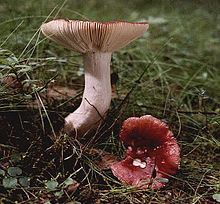| Russulales | |
|---|---|

| |
| Russula emetica | |
| Scientific classification | |
| Domain: | Eukaryota |
| Kingdom: | Fungi |
| Division: | Basidiomycota |
| Class: | Agaricomycetes |
| Subclass: | incertae sedis |
| Order: | Russulales Kreisel ex P.M.Kirk, P.F.Cannon & J.C.David (2001) |
| Families | |
|
Albatrellaceae | |
| Synonyms[1] | |
| |
The Russulales are an order of the Agaricomycetes, (which include the agaric genera Russula and Lactarius and their polyporoid and corticioid relatives). According to the Dictionary of the Fungi (10th edition, 2008), the order consists of 12 families, 80 genera, and 1767 species.[2] According to Species Fungorum (January 2016), the order contains 13 families, 117 genera (16 not assigned to a family), and 3,060 species.[3]
Russuloid agarics represent an independent evolutionary line of agarics, not directly related to the Agaricales.
This group also includes a number of russuloid hypogeous fungi, polypores such as Bondarzewia, some tooth fungi (e.g. Auriscalpium vulgare), and club fungi e.g. Artomyces.[4] Basidiospores in this group are typically ornamented with amyloid warts or reticulation but a few exceptions are known, e.g. Heterobasidion annosum. The genus Clavicorona was often treated in the Russulales, but its type species, C. taxophila, is in the Agaricales. The remaining species are retained in the Russulales in the genus Artomyces.[5]
- ^ "Russulales Kreisel ex P.M. Kirk, P.F. Cannon & J.C. David 2001". MycoBank. International Mycological Association. Retrieved 2010-11-05.
- ^ Kirk PM, Cannon PF, Minter DW, Stalpers JA (2008). Dictionary of the Fungi (10th ed.). Wallingford, UK: CABI. p. 609. ISBN 0-85199-826-7.
- ^ Kirk PM. "Species Fungorum (version January 2016). In: Species 2000 & ITIS Catalogue of Life". Species 2000 & ITIS. Retrieved 2014-10-30.
- ^ Miller, S.L.; et al. (2006). "Perspectives in the new Russulales". Mycologia. 98 (6): 960–970. doi:10.3852/mycologia.98.6.960. PMID 17486972.
- ^ Lickey, E.B.; et al. (2003). "Phylogenetic and taxonomic studies in Artomyces and Clavicorona (Homobasidiomycetes: Auriscalpiaceae)". Sydowia. 55: 181–254.